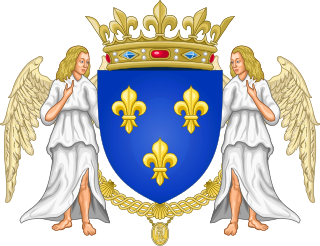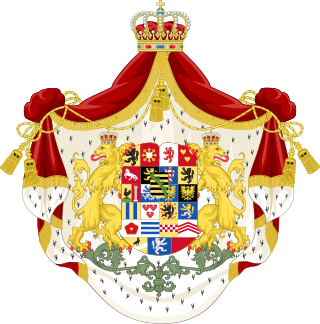The Capetian dynasty, also known as the "House of France", is a dynasty of European origin, and a branch of the Robertians. It is among the largest and oldest royal houses in Europe and the world, and consists of Hugh Capet, the founder of the dynasty, and his male-line descendants, who ruled in France without interruption from 987 to 1792, and again from 1814 to 1848. The senior line ruled in France as the House of Capet from the election of Hugh Capet in 987 until the death of Charles IV in 1328. That line was succeeded by cadet branches, the Houses of Valois and then Bourbon, which ruled without interruption until the French Revolution abolished the monarchy in 1792. The Bourbons were restored in 1814 in the aftermath of Napoleon's defeat, but had to vacate the throne again in 1830 in favor of the last Capetian monarch of France, Louis Philippe I, who belonged to the House of Orléans. Cadet branches of the Capetian House of Bourbon are still reigning over Spain and Luxembourg.

The House of Bourbon is a dynasty that originated in the Kingdom of France and is a branch of the Capetian dynasty, the royal House of France. Bourbon kings first ruled France and Navarre in the 16th century, and by the 18th century, members of the Spanish Bourbon dynasty held thrones in Spain, Naples, Sicily, and Parma. Today Spain and Luxembourg have monarchs of the House of Bourbon. The royal Bourbons originated in 1272, when Robert, the youngest son of King Louis IX of France, married the heiress of the lordship of Bourbon. The house continued for three centuries as a cadet branch, serving as nobles under the direct Capetian and Valois kings.

Morganatic marriage, sometimes called a left-handed marriage, is a marriage between people of unequal social rank, which in the context of royalty or other inherited title prevents the principal's position or privileges being passed to the spouse, or any children born of the marriage. The concept is most prevalent in German-speaking territories and countries most influenced by the customs of the German-speaking realms.
A prince is a male ruler or a male member of a monarch's or former monarch's family. Prince is also a title of nobility, often hereditary, in some European states. The female equivalent is a princess. The English word derives, via the French word prince, from the Latin noun prīnceps, from primus (first) and caput (head), meaning "the first, foremost, the chief, most distinguished, noble ruler, prince".

The Capetian house of Valois was a cadet branch of the Capetian dynasty. They succeeded the House of Capet to the French throne, and were the royal house of France from 1328 to 1589. Junior members of the family founded cadet branches in Orléans, Anjou, Burgundy, and Alençon.
The Most Serene House of Bourbon-Condé, named after Condé-en-Brie, was a French princely house and a cadet branch of the House of Bourbon. The name of the house was derived from the title of Prince of Condé that was originally assumed around 1557 by the French Protestant leader Louis de Bourbon (1530–1569), uncle of King Henry IV of France, and borne by his male-line descendants.
An appanage, or apanage, is the grant of an estate, title, office or other thing of value to a younger child of a monarch, who would otherwise have no inheritance under the system of primogeniture. It was common in much of Europe.

The Legitimists are royalists who adhere to the rights of dynastic succession to the French crown of the descendants of the eldest branch of the Bourbon dynasty, which was overthrown in the 1830 July Revolution. They reject the claim of the July Monarchy of 1830–1848 which placed Louis Philippe, Duke of Orléans, head of the Orléans cadet branch of the Bourbon dynasty, on the throne until he too was dethroned and driven with his family into exile.

Holstein-Gottorp or Schleswig-Holstein-Gottorp is the historiographical name, as well as contemporary shorthand name, for the parts of the duchies of Schleswig and Holstein, also known as Ducal Holstein, that were ruled by the dukes of Schleswig-Holstein-Gottorp, a side branch of the elder Danish line of the German House of Oldenburg. Other parts of the duchies were ruled by the kings of Denmark.

Duke of Bourbon is a title in the peerage of France. It was created in the first half of the 14th century for the eldest son of Robert of France, Count of Clermont, and Beatrice of Burgundy, heiress of the lordship of Bourbon. In 1416, with the death of John of Valois, the Dukes of Bourbon were simultaneously Dukes of Auvergne.

The 4th House of Orléans, sometimes called the House of Bourbon-Orléans to distinguish it, is the fourth holder of a surname previously used by several branches of the Royal House of France, all descended in the legitimate male line from the dynasty's founder, Hugh Capet. The house was founded by Philippe I, Duke of Orléans, younger son of Louis XIII and younger brother of Louis XIV, the "Sun King".

The House of Saxe-Coburg and Gotha is a European royal house. It takes its name from its oldest domain, the Ernestine duchy of Saxe-Coburg and Gotha, and its members later sat on the thrones of Belgium, Bulgaria, Portugal, and the United Kingdom and its dominions.
A substantive title is a title of nobility or royalty acquired either by individual grant or by inheritance. It is to be distinguished from a title shared among cadets, borne as a courtesy title by a peer's relatives, or acquired through marriage.

The House of Courtenay is a medieval noble house, with branches in France, England and the Holy Land. One branch of the Courtenays became a royal house of the Capetian dynasty, cousins of the Bourbons and the Valois, and achieved the title of Latin Emperor of Constantinople.

The Bourbon-Busset family is a cadet branch of the House of Bourbon, being thus agnatic descendants of the Capetian dynasty. Historically, they have been regarded as non-dynastic since decisions rendered by Louis XI of France.
The Orléanist claimant to the throne of France is Jean, Count of Paris. He is the uncontested heir to the Orléanist position of "King of the French" held by Louis-Philippe, and is also considered the Legitimist heir as "King of France" by those who view the 1713 Treaty of Utrecht as valid. According to the Family Compact of 1909, only the descendants of Henri, Count of Paris are considered to be French dynasts. The founders of the cadet branches of Orleans-Braganza and Orléans-Galliera, by becoming foreigners, are considered under house law to have lost their rights to the throne.

The House of Bourbon-Two Sicilies is a cadet branch of the House of Bourbon that ruled Southern Italy and Sicily for more than a century in the 18th and 19th centuries. It descends from the Capetian dynasty in legitimate male line through Philippe de Bourbon, Duke of Anjou, a younger grandson of Louis XIV of France (1638–1715) who established the Bourbon dynasty in Spain in 1700 as Philip V (1683–1746). In 1759, King Philip's younger grandson was appanaged with the kingdoms of Naples and Sicily, becoming Ferdinand IV and III (1751–1825), respectively, of those realms. His descendants occupied the joint throne, merged as the "Kingdom of the Two Sicilies" in 1816, until 1861, claimed it thereafter from exile, and constitute the extant Bourbon-Two Sicilies family.
Bourbon-Vendôme refers to two branches of the House of Bourbon, the first of which became the senior legitimate line of the House of Bourbon in 1527, and succeeded to the throne of France in 1589 with Henry IV. He created the second house by granting the dukedom of Vendôme to one his legitimized sons.

A prince du sang or prince of the blood is a person legitimately descended in male line from a sovereign. The female equivalent is princess of the blood, being applied to the daughter of a prince of the blood. The most prominent examples include members of the French royal line, but the term prince of the blood has been used in other families more generally, for example among the British royal family and when referring to the Shinnōke in Japan.











